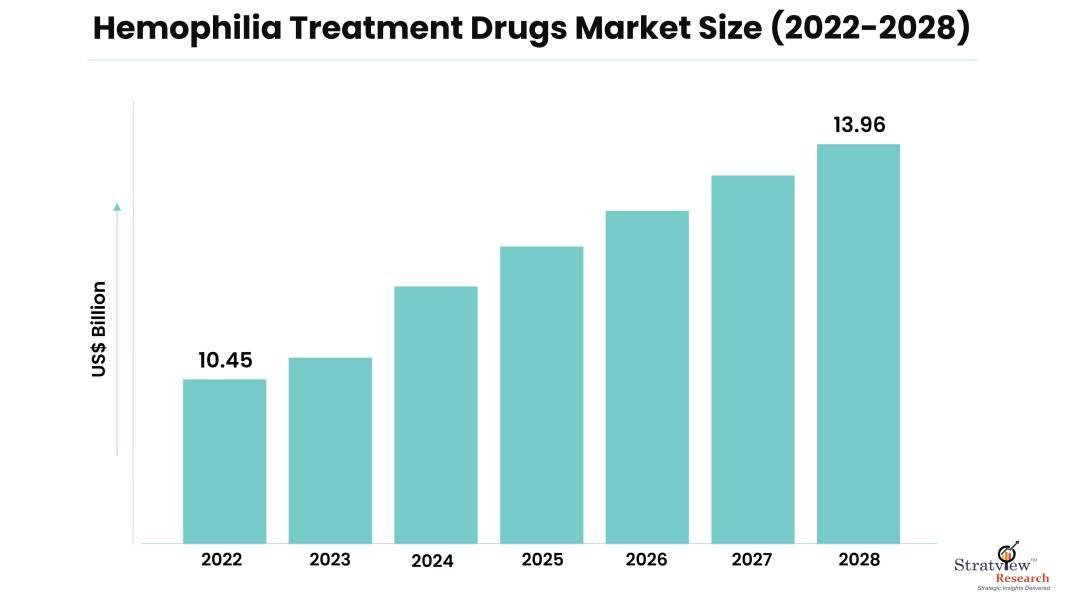Hemophilia is a rare genetic bleeding disorder caused by a deficiency in one of the blood clotting factors, factor VIII or factor IX. This can lead to excessive bleeding, even from minor injuries. Hemophilia is a lifelong condition, but significant progress has been made in recent years in developing new and more effective treatments.
The global hemophilia treatment drugs market is estimated to grow from USD 10.45 billion in 2022 and is likely to grow at a CAGR of 4.9% during 2023-2028 to reach USD 13.96 billion by 2028. This growth is being driven by a number of factors, including:
- Increasing awareness and diagnosis of hemophilia
- Growing demand for prophylactic treatment
- Rising investments in research and development of new therapies
- Expanding access to treatment in developing countries
New treatment options for hemophilia
The traditional treatment for hemophilia is intravenous infusions of the missing blood clotting factor. However, this can be inconvenient and time-consuming for patients, and it may not be effective for all patients. In recent years, a number of new treatment options have been developed that offer greater convenience and efficacy.
One of the most significant developments in hemophilia treatment has been the introduction of extended-half-life (EHL) factor concentrates. EHL factor concentrates remain in the bloodstream for a longer period of time than traditional factor concentrates, which means that patients need to inject less often. This can be a major improvement in quality of life for patients.
Another important development is the introduction of non-factor therapies. Non-factor therapies work in different ways to promote blood clotting, and they can be used for patients with hemophilia who have developed inhibitors to factor concentrates.
Some of the key new treatment options for hemophilia include:
- Emicizumab (Hemlibra): Emicizumab is a monoclonal antibody that mimics the function of factor VIII in the blood clotting cascade. It is approved for the treatment of hemophilia A in adults and children of all ages.
- Fitusiran (Hemgenix): Fitusiran is an RNA interference drug that silences the gene responsible for hemophilia A or B. It is approved for the treatment of hemophilia A and B in adults.
- Eloctate (Eloctate): Eloctate is an EHL factor VIII concentrate that is approved for the treatment of hemophilia A in adults and children of all ages.
- Nonacog alfa (Recombinate LA): Nonacog alfa is an EHL factor IX concentrate that is approved for the treatment of hemophilia B in adults and children of all ages.
Challenges in the hemophilia treatment drugs market
Despite the significant progress that has been made in recent years, there are still a number of challenges in the hemophilia treatment drugs market. One of the biggest challenges is the high cost of treatment. Hemophilia drugs are some of the most expensive medications in the world. This can make them inaccessible to many patients, especially those in developing countries.
Another challenge is the lack of access to treatment in some parts of the world. In many developing countries, there is a shortage of hemophilia drugs and treatment centers. This can make it difficult for patients to get the care they need.
The future of hemophilia treatment
The future of hemophilia treatment is bright. Researchers are developing new and even more effective therapies, such as gene therapy. Gene therapy has the potential to cure hemophilia completely. However, gene therapy is still in the early stages of development, and it will likely be several years before it is available to patients.
In the meantime, new hemophilia drugs are continuing to be developed and approved. These drugs are offering patients greater convenience, efficacy, and quality of life.
Conclusion
The hemophilia treatment drugs market is evolving rapidly, driven by the development of new and more effective therapies. These new therapies are offering patients greater convenience, efficacy, and quality of life. However, the high cost of treatment and the lack of access to treatment in some parts of the world remain challenges.
